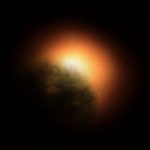‘Great Dimming’ of Betelgeuse star is solved0
- From Around the Web, Space
- June 16, 2021
Astronomers say they’ve put to bed the mystery of why one of the most familiar stars in the night sky suddenly dimmed just over a year ago.

Astronomers say they’ve put to bed the mystery of why one of the most familiar stars in the night sky suddenly dimmed just over a year ago.

The bright star’s great dimming may have been a big dust burp

Using new observational data from the space-based Solar Mass Ejection Imager and three different modeling techniques, astronomers have found that Betelgeuse, a red supergiant in the constellation of Orion, has a radius of about 764 solar radii, a mass between 16.5 and 19 solar masses, and is 548 light-years away.

Astronomers have determined the cause of the dramatic dimming observed last year and earlier this year of one of the brightest stars in the night sky, a colossus called Betelgeuse that appears to be on its way toward a violent death.

The red supergiant Betelgeuse is one of the brightest stars in the night sky and appears even more luminous because it is so close to Earth, only 650 light-years away. But the star also periodically changes in brightness, which was first noted in the 1830s by the British astronomer John Herschel. Betelgeuse experienced an unexpected dimming during December 2019 and the first quarter of 2020, reaching an historic minimum on February 7-13. This dimming has mystified astronomers, who scrambled to develop several theories for the abrupt change. Ultraviolet observations by the NASA/ESA Hubble Space Telescope suggest that the dimming was probably caused by an immense amount of superhot material ejected into space. The material cooled and formed a dust cloud that blocked the starlight coming from about a quarter of Betelgeuse’s surface.

Betelgeuse, the bright star in the constellation of Orion, has been fascinating astronomers in the recent months because of its unusually strong decline in brightness. Scientists have been discussing a number of scenarios trying to explain its behavior. Now a team led by Thavisha Dharmawardena of the Max Planck Institute for Astronomy have shown that most likely unusually large star spots on the surface of Betelgeuse have caused the dimming. Their results rule out the previous conjecture that it was dust, recently ejected by Betelgeuse, which obscured the star.

For months, astronomers have been keeping a wary eye on Betelgeuse, the bright red star in Orion’s shoulder.

One of the brightest stars in the sky makes up Orion’s shoulder and also looks to be on the verge of going supernova sometime between today and 100,000 years from today.